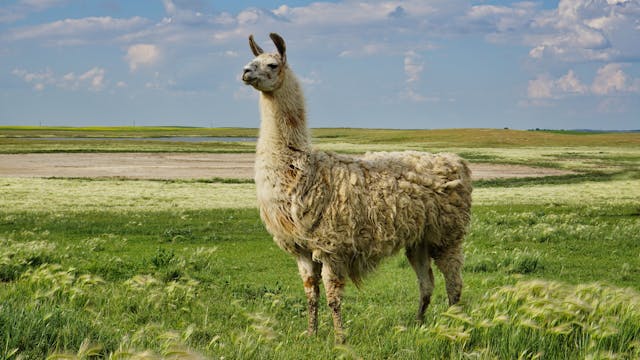
What is a guard llama? It is a llama that lives with sheep or goats and protects them from predators, such as coyotes.
Llamas are animals that are native to South America, although they have been spread all over the world since Spain colonized South America. They look like large sheep, but they are members of the camel family. If you look closely at their faces, you can see the resemblance to a camel. They tend to live together in herds and they are very social animals. They were used as pack animals by the Spanish and they were made to carry ore down from the mines. They are not as strong as horses and they can generally carry about 30 % of their body weight for roughly 10 km. That is not as much or as far as a horse or a donkey can carry a load and once the Spanish introduced horses into South America, they stopped using llamas to carry loads.
So, what is a guard llama? Well, have you heard of guard dogs? A guard llama is like that, except they guard sheep or goats. Starting in the 1980s, some farmers have started to use llamas to guard their animals. Those farms that use llamas have seen a huge fall in the number of animals that are killed by predators and nearly every farmer that uses a guard llama speaks highly of them. There are several ways to protect a flock of sheep on a farm, and they all have a lot of disadvantages. A high wall is possible, but it needs to be built and maintained. It also doesn’t give sheep the ability to find more food if it runs out. Foxes and other wild predators can also get through breaks and gaps in a fence, or even dig under them. Poison is also a possibility. Poisoned bait can be left out for the predators, but there is a big chance that they won’t eat it and there is also the possibility that it could poison other animals. Sheep dogs are also a good deterrent, but they are expensive to keep and they don’t have a very long life expectancy. They also need to be trained. Sheep and goats also get very stressed around sheep dogs. So, what is a solution? Well, it turns out that llamas are a very effective solution to this problem.
One llama is used to guard a flock of 300 or so sheep, although they can guard more. They can also guard goats, chickens, and other animals, but sheep seem to be the most common. Usually, a castrated male is used because if they are not castrated, they may try to mate with the sheep. The llama’s usefulness as a guard comes in because they are incredibly social. They are pack animals and they are used to living in groups. They are also very eager to defend their own group. When a llama is introduced to a flock of sheep, they very quickly bond and see all of the sheep as their own group. That means, they are very eager to defend the sheep. A llama costs about $2,000, but they live for twenty years, so they are much more cost efficient than guard dogs.
The most common predators of sheep that are grazed in the wild are foxes, wild dogs, coyotes, mountain lions, and bears. You wouldn’t think it, but llamas can fight most of these predators off. Llamas are about 1.8 m tall on average and they can weigh between 130 and 270 kg. They have excellent eye sight, very good hearing, and they are incredibly fast. They can run at about 65 km/h. Guard llamas become part of the flock and they are always on alert, looking for danger. They are very tall, so they can see much further than a dog can. If they see a predator, their first reaction is to herd the sheep into a safe place. They do this naturally, without the commands that a sheep dog would need. Once the sheep are safe, the llama puts itself between the sheep and the threat. Then it starts to cry. A llama’s cry sounds like a very loud rusty grate mixed with the screams of an animal in pain. It is a very loud and very shrill sound. Not pleasant at all. This sound is enough to make most predators flee. If the predator isn’t deterred and decides to try its luck, the llama will rush them. A llama is big and formidable when running at you. It also has four long legs and it will rear up on its hind legs to kick and stomp. It wouldn’t be a match for a pack of wolves, but one or two animals it can see off pretty easily. There are accounts of llamas killing coyotes and scaring off bears. Studies have shown that llama guards are extremely successful and the llamas will go to any length to protect the flock they are with. And this is what I learned today.
Photo by Bryan Smith: https://www.pexels.com/photo/photo-of-a-llama-on-a-grass-field-11882071/
Sources
https://www.alpacamagic.com.au/livestock-guardians
https://www.spokesman.com/stories/1996/mar/19/beware-of-llama-animals-bond-with-sheep-then-will
https://en.wikipedia.org/wiki/Guard_llama
